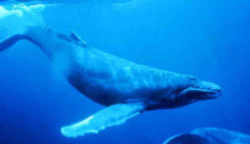
Hawaii Symbols
Hawaii State Marine Mammal
Humpback Whale

(Megaptera novaeangliae)
Adopted in 1979.
Hawaii designated the endangered humpback whale, (Megaptera novaeangliae), as official state marine mammal in 1979. Hawaii adopted another mammal symbol in 2008 - the Hawaiian monk seal (also endangered).
Each winter, Hawaii welcomes and shelters entire herds of humpback whales as they migrate from northern waters to their traditional calving grounds off the island of Maui. The humpback whale is an endangered migratory whale that gets its name from the way it arches, or humps, its back when it dives. Female humpback whales can be up to 52 ft long. As with all whales, the male is slightly smaller.
Hawaii State Marine Mammal: Humpback Whale

This spectacular animal has been designated the official Animal. Hawaii offers a safe haven for the humpback, and the opportunity for the scientific community to study whales in a protected environment.
The humpback whale is an endangered migratory baleen whale that occurs in all ocean basins of the world. More than 28,000 North Pacific humpbacks were killed by commercial whalers in the twentieth century, reducing their population to approximately 1,000 animals by the mid-1960's. By the end of the 1965 hunting season, when the International Whaling Commission instituted a moratorium on commercial hunting of humpbacks, their worldwide population had dwindled from more than 125,000 before exploitation to an estimated 10,000. The humpback whale was classified as an endangered species in 1973 when the U. S. Endangered Species Act was implemented. At present, there is no precise estimate of the worldwide humpback whale population.
Identification of the Humpback Whale
The humpback whale is one of the most easily recognizable of the large whales. Often the first sign of its presence is its 'blow', a cloud of vapors that it shoots into the air when it breaks the surface to breath.
Humpbacks get their name from the way they arch, or hump, their backs when they begin their dives. They will often roll forward to dive until only the tail sticks out of the water. This is called a fluke-up dive.
Humpback whales can launch themselves out of the water in a spectacular motion called breaching. Seen from any distance, this action is one of the most dramatic and awe-inspiring in the animal kingdom.
The features of a humpback whale are:
- A dark grey or black body, with white patches on its belly, pectoral fins and underside of the tail flukes.
- Long pectoral fins which are almost all white underneath, with bumps on the leading edges. Unlike any other whale, the humpback's flukes and pectoral fins are scalloped or serrated on the trailing edge.
- A slim head, or rostrum, covered with knobs with a distinctive rounded protuberance near the tip of the lower jaw.
- Large numbers of barnacles often covering both the rostrum and pectoral fins.
- A small dorsal fin.
Humpbacks are baleen whales. They don't have any teeth, and feed by filtering shrimp-like krill between 270-400 baleen plates which hang from the top jaw.
Humpbacks are also rorquals, whales which have distinctive throat grooves. They have up to 35 broad ventral throat grooves, extending at least to their navels. Their bodies are more robust than those of other rorquals.
Female humpback whales can be up to 16 m long. As with all baleen whales, the male is slightly smaller.
Hawaii Law
The law designating the Hawaiian monk seal as the official Hawaii state mammal is found in the Hawai`i Revised Statutes, Volume 1, Chapter 5, Section 5-12
Volume 1.
CHAPTER 5. EMBLEMS AND SYMBOLS.
SECTION -5-12
[§5-12] State marine mammal. The humpback whale is established and designated as the official marine mammal of the State, to be effective so long
as the legislature of the State does not otherwise provide. [L 1979, c 110, §1]
Taxonomic Hierarchy: Humpback Whale
Kingdom: Animalia
Phylum: Chordata
Class: Mammalia
Subclass: Eutheria
Order: Cetartiodactyla[a]
(unranked): Cetacea
(unranked): Mysticeti
Family: Balaenopteridae
Genus: Megaptera - Gray, 1846
Species: M. novaeangliae







